MacGregors Are Driven Out
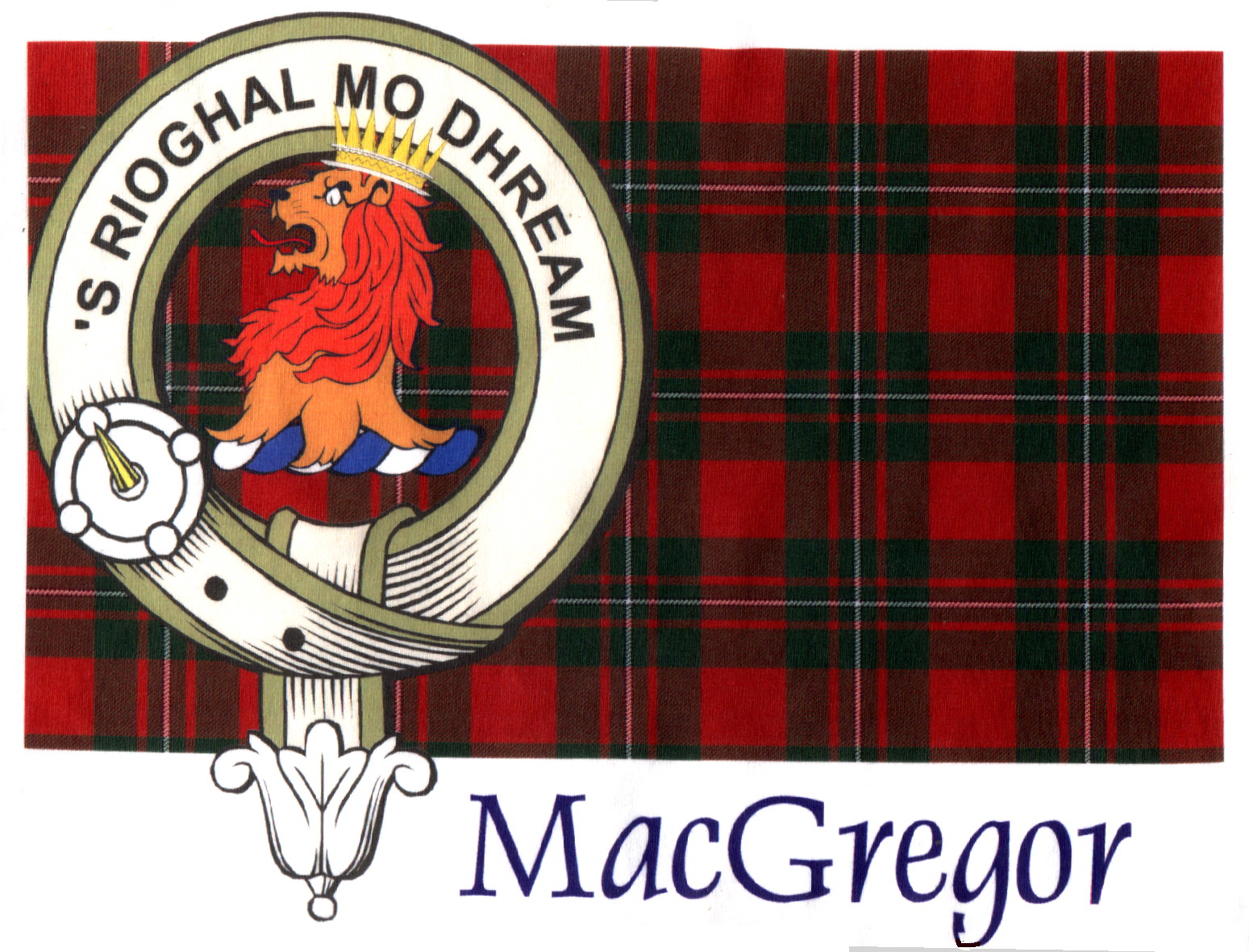
![]()
MacGregors Flourish in A Violent Society
The first area held by clan Gregor was around Glen Dochart. Glenorchy was bestowed on the MacGregors in 1222 by Alexander II for their help in his conquest of Argyll. By 1296, clan Gregor had expanded westward and northward to occupy other areas in Dalriada, these were around Glenorchy and the Glens surrounding Loch Awe. There was opposition to clan Gregor expansion but their right of the sword, or in Gaelic, Coir a Chlaiheamh, was too powerful an argument to resist. This was the traditional method of gaining and holding land, and until a better system was developed, the MacGregors would use this one. In those days, every clan had to fight to maintain its territory or perish. At their zenith, they controlled vast areas of Perthshire and Argyle. Entire towns and the countryside were recognized as MacGregor clan property.
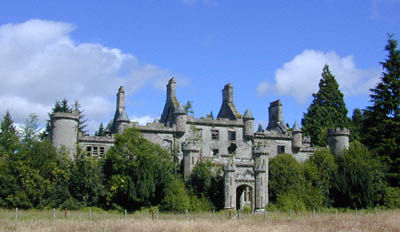
So numerous were they that their men were known by their
particular trades, physical traits or appearances, and/or their first names.
Aboriginal people were incorporated into the clan and intermarried with them.
Their fierceness and clan loyalties were the stuff of legend - and
fear. Neighbours as far away as the Lowland burgh of Glasgow prayed at night for
deliverance from the MacGregors. As long as they supported the triumphant monarch
of the day, their future was assured. The Scotland they knew was a network of
intrigue and aggression. It was a violent time - with the need for strong
clans and stronger leaders. Clan Chiefs were, in effect, sub-kings
in the old Pict tradition, with the
power of life or death over their subjects- and the clan Gregor or 'Clan Gregarach'
controlled a vast area in the very centre of Scotland.
![]()
The Scottish Crown is Usurped by Normans
Edinburgh wasn't brought under the king's influence until AD962. The Angles,
a Teutonic people who controlled the Lothian south of the country, were not subjugated until
1018. The Norse Scots in the western Isles, the Orkneys, Faroes, Shetlands
and the north coast owed more allegiance to the
far away King of Norway than to Scotland, they acted as if they were Kingdoms of their own
and were not completely brought into the Scottish fold until William of Orange sent an
army of Campbell regiments on to their settlements and treacherously massacred many in
their beds in 1692.
The collapse of England in 1066 to the invading Northmen under 'William the Conqueror'
drove many Anglo-Saxon lords northwards, turning southern Scotland into an aristocratic
refugee camp. These new immigrants, cunning and seeking revenge, persuaded
Scottish kings to invade England, repeatedly. It was only a matter of time before
the English 'lion' would turn on the Scottish 'Boar' and route her.
William Rufus, the Conqueror's son, was successful in usurping the Scottish throne and
placed puppets there who would do his bidding. Soon, Norman lords appeared in
southern Scotland and they brought European feudalism with them. These
transplanted French-speaking Norman lords eventually gained control of Scotland and
quickly began attacking the indigenous Pictic/Gaelic Highland clans they could not
completely control.
![]()
Edward I of England Dreams of an Empire and Invades
Scotland
Edward went home confident that Scotland was now subdued.
He was very wrong. The horrible atrocities he and his army committed would fuel
the fires of rebellion in Scotland. And when a little known man, named William
Wallace, came to the forefront of Scottish patriotism -- he made history.
![]()
THE SCOTS WA HAE WI WALLACE BLED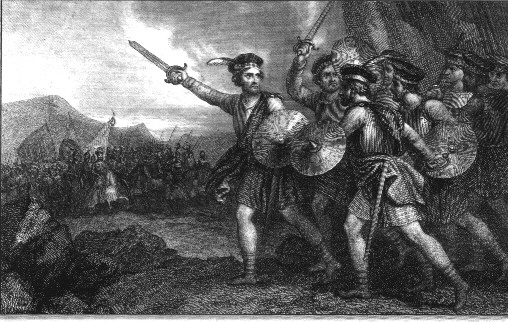
William Wallace was THE greatest Scottish
patriot Scotland has ever had, and he came when the Scots needed him most.
The name 'Wallace' derives from the Latin term 'Wallensis', which means Welsh. In
this case, however, it denotes the Britons of Strathclyde, who came from the same
Pict
racial stock.
Here is the entire Poem dedicated to those who served and bled under Wallace:
Scots, wha hae wi' Wallace
bled
Scots, wham Bruce has aften led
Welcome to your gory bed
Or to victory!
Now's the day an' now's the hour
See the front of battle lour
See approach proud Edward's pow'r
Chains and slavery!
Wha would be a traitor knave?
Wha would fill a coward's grave?
Wha sae base as be a slave?
Let him turn and flee!
Wha for Scotland's king an' law
Freedom's sword would strongly draw
Freeman stand and freeman fa'
Let him on wi' me!
By oppression's woes and
pains
By your sons in servile chains
We will drain our dearest veins
But they shall be free.
Lay the proud userpers low!
Tyrants fall in ev'ry foe
Liberty's in every blow
Let us do or dee!
Author: Robert Burns
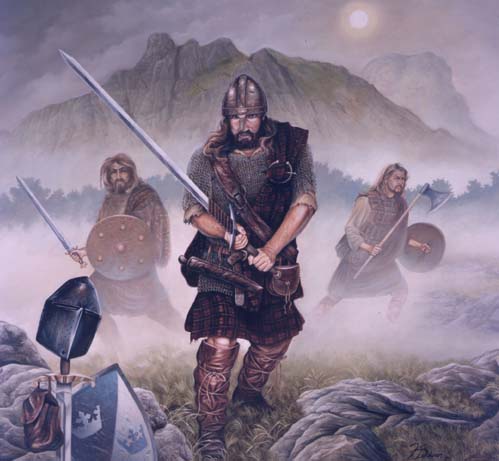
When William Wallace rose up against the English occupiers, all true Highlanders came to his call. Among them were the entire clan Gregor. Wallace won several skirmishes and then the major battle of Stirling Bridge.
Edward (Longshanks) then gathered all available forces from Normandy, Ireland, Wales, and England for a huge invasion. He was a cunning and ruthless strategist, and met Wallace at Falkirk in 1296.
Edward was also reinforced by some Scottish aristocrats and traitors (who considered Wallace to be of low birth and not good enough to lead Scotland's War of Independence against the English), including the Earl of Dunbar.
The night before the fateful battle, Wallace had planned to lead a night attack against the English, but three traitorous Scots went to the English camp and warned them of Wallace's plan.
Those
three traitors have never been named. It has been suspected down through
the ages aht Bruce was one of them. 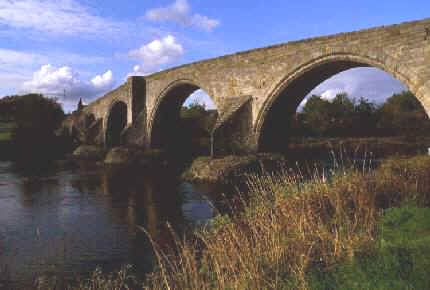
Unfortunately, Edward won the battle. Iain (John) MacGregor of GlenOrchy, Chief of the Gregor clan, was captured and taken hostage by Edward, and was forced to sign an agreement to pay homage to Edward for his lands in Glen Orchy and to fight in an upcoming English war with France.
Wallace was hunted down, betrayed, taken to London, put on trial, hanged, quartered, and beheaded. His body parts were sent to various places in Scotland as a warning to others of like mind.
Meanwhile, Iain died childless, and his widow married a
Campbell, which "allowed the Dragon into the House", and led to the
undoing of the Clan Gregor.
![]()
Robert The Bruce Wins Scottish Independence- For a Time
The next challenger to the English presence was Robert Bruce, who was
descended from the Norman 'de Brus' family. He rallied most of Scotland's nobles,
and was successful in attracting most of the Highland clans to his cause. He fought
a number of skirmishes against the English, and lost them all. While in hiding in a
cave in Ireland, he was inspired by the persistence of a spider trying to climb back up on
a strand of its silk, and returned to fight the new English king Edward II. At the
battle of Bannockburn in 1314, the English outnumbered the Scottish forces 20,000 to
6,000. However, by shrewd maneuvering, Bruce managed to hold the high ground and
forced the English into a swampy area where they met utter defeat.
Malcom MacGregor was a Chief of the MacGregor clan in the days of Robert
Bruce. He fought bravely at Bannockburn and went with Edward Bruce, Robert's
brother, to Ireland, where he was wounded at Dundalk, he was ever afterwards known as
"the lame lord."
Clan Gregor Is Betrayed By Bruce
Bruce was declared King with the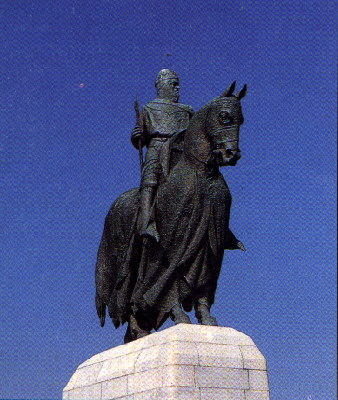 blessing of France
and the Pope. The English did not recognize Scotland's independence until 1328, when
the next English king, Edward III decided Scotland was more trouble than it was
worth, and sent his younger sister to marry Bruce's baby son.
blessing of France
and the Pope. The English did not recognize Scotland's independence until 1328, when
the next English king, Edward III decided Scotland was more trouble than it was
worth, and sent his younger sister to marry Bruce's baby son.
Bruce had not experienced an easy career. He had been hunted like a fox before
Bannockburn. Afterwards, he still had enemies among the fierce Gaelic Highland clans,
including the Humes, FitzGilberts, Carlyles, Colvilles, MacDougals, MacNabs, most of the
powerful clan MacDonald, and the powerful MacGregors of Glen Orchy. Many
Highland clans fought for Bruce because Scottish independence was a
strong rallying point against the cursed English, but they could not forgive Bruce for his
betrayal at Dunbar and of his unenthusiastic support of Wallace.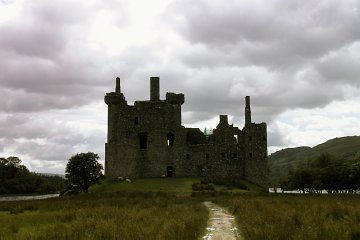
Bruce bore numerous grudges against these Highland clans who fought so valiantly for Wallace but now considered him a usurper. He retaliated by decreeing certain lands of his enemies to his supporters. Among these, the Barony of Loch Awe, site of the largest MacGregor fort, Kilchurn, was decreed to the Campbells by Bruce as retribution against MacGregor's (of Glen Orchy) intransigence.
This is how clan Gregor began to lose properties to the Norman usurpers and their lackeys, the Campbells.
![]()
Enter the Norman House of Stewart-
When the Bruce dynasty failed to produce a son, by court
intrigue, the crown passed in 1371 to the first of the Stewarts, Robert
II. The Stewarts took their name from their function as High Stewards to the King.
They were descended from the Fitzalans, Normans who came to England with William
the Conqueror in 1066. Thus the upstart Stewarts, or Stuarts (as they were later
renamed by Mary) became the last Royal family of Scotland.
With the advent of the Bruce and Stuart families to power, Norman-descended families would
continue to dominate Scotland . They called themselves 'Scottish', although they had
not a drop of Scottish, Pict, Norse, Dane, Angle, or Welsh blood.
They held nothing but contempt for the Scots/Picts Highlanders who
still represented a majority of the population, and in particular, several clans of the
Sol Alpin who claimed to be Royal descendants of the Alpin
dynasty, others of the last Pict King, Gregor MacDunegal, -
who
represented the last cohesive Pict group in all of ancient Scotland.
With the opposition by the Argyll-shire (Glen-Orchy) MacGregors to Robert Bruce, Clan Gregor lost its influence at the Scottish court and never regained it. In 1359, the Glenorchy line of MacGregor Chiefs ended childless. At the instigation of Sir Colin Campbell of Loch Awe, a Royal decree passed the entire Glenorchy lands to his son, conveniently John Campbell, the new husband of the grieving widow.
The three nephews of the deceased Chief did not accept this manoeuvre and declared MacGregor lands in Glenorchy would remain free of the Campbells forever. The male line of the old family, descended from Iain's nephew Gregor, would not submit to another clan and continued to hold their ancestral territory as long as they could by the sword.
This 'Gregor of the Golden Bridles' became Chief, and his son, Iain 'the One-eyed' of GlenOrchy, inherited the Chiefship of the GlenOrchy branch of the Clan Gregor.
Duncan MacGregor defied the Royal Proclamation, and their revolt became
the basis of a four century struggle for independence by MacGregors from Campbell tyranny.
In their tortuous long struggle against their new Lairds, the
Glenorchy-MacGregors became known as the most aggressive of all MacGregors.
Luck swung to the MacGregor side when, with the death of the Campbell's only heir, Glen
Orchy reverted back to the MacGregors - for a time.
In a typical Campbell manoeuvre, 'Black' Duncan Campbell, with two accomplices, rode up to
Achallader and all three put their horses to feed in a Fletcher's uncut field of
corn. Fletcher rushed out and shot one of the trespassers. Being forced to
flee by the law, he was kindly offered a chance to preserve his lease by lending it to
Campbell until he could safely return. Needless to say, he could never persuade
Campbell to return his lease.
![]()
Campbells and Stewarts Grab Slices of MacGregor Property
In the reign of David II, a weak king, who was influenced greatly by court
manipulators, the Campbells were granted legal title to the lands of Glenorchy,
nevertheless the MacGregors maintained actual possession of them by the ancient Scottish
tradition of "Right of the Sword".
Ghriogair of the Golden Bridles (b~1300; d~1360),
was the first recognized Supreme Chief of the Clan Gregor. It was to him,
the sub-Chiefs rallied to give him unconditional support in the face of the
horrific depredations by the Campbell dragon. In a show of unity, all
Chiefs agreed to change the name of the Clan from Clan Alpine to Clan Gregor in
support of their Grand Chief.
Gregor's son, Eoin cam (Ian of the One-Eye), b~1325; d~1390, leaving three sons: Patrick,
his successor at GlenOrchy; John Dow, ancestor of the family at Glenstrae, and
Gregor, ancestor of the MacGregors of Roro. Patrick's son, Malcom, was
compelled by the Campbells to sell the lands of Auchinrevach in Strathfillian to
Campbell of Glenorchy, who thus obtained the first footing in Breadalbane, which
afterwards gave the title of "Earl of Breadalbane" to his family.
The principle families of MacGregors, in process of time, except for those in
Glenstrae, who held that estate as vassals of the Earl of Argyll, found themselves reduced
to the position of tenants on the lands of Campbell of Glenorchy and other powerful
barons. From this time, the Chiefs of Glenstrae, being the only remaining relatively
free clansmen, were generally accepted as the hereditary Clan Gregor chiefs.
It being the policy of these barons to get rid of their unrelated tenants
altogether, the unfortunate clan was driven, by a continuous system of oppression
and annoyance, to acts of violence, which brought upon them the vengeance of the
government. The clan had no other means of sustenance but the plunder of their
neighbours' property, and as they naturally directed their attacks against those who had
wrested their lands from them, it became the aim of their oppressors to obtain royal
assistance in 'cutting off the tribe of MacGregor, root and
branch.'
![]()
Clan Gregor Is Outlawed and Forced Into Lawlessness-
In 1488, the youthful James III, passed an act " for staunching of thrifteif and other enormities throw all the realme
"; evidently designed specifically against the MacGregors, as among the barons
appointed to enforce the decree, was Duncan Campbell of Glenorchy, Neil Stewart of
Fortingall, and Ewin Campbell of Strachur, all landowners desperate to rid themselves of
the "MacGregor menace." These men
were now 'above the law' in their respective estates, and now they had a Royal
decree allowing them an unfettered right to terrify the MacGregors out of existence.
The Stewarts used this tool to slaughter the entire community of MacIvers and MacLivers in
Glenlyon, which they took for themselves.
This act aimed at destroying the MacGregors served only to rouse them to greater acts of
violence. At this time, the MacGregors were still a powerful force. Besides
those in Glenorchy, they were in great numbers in the districts of Breadalbane and Athol,
and they all acknowledged MacGregor of Glenstrae as their Chief and protector. On
the other hand, the current Scottish King, James III, was soon assassinated by a
group of treacherous nobles. Therefore, it should not be surprising that a
"Royal Proclamation" was considered a sick joke by the MacGregors in those
times.
With the aim of reducing these branches, Sir Duncan Campbell of GlenOrchy obtained in
1492, the office of baillery of the crown lands of Disher and Toyer, Glenlyon, and
GlenDochart, and in 1502, he procured a charter of the lands of Glenlyon. From
this time, the history of the MacGregors consisted merely of succeeding acts of the Privy
Council, by which commissions were granted to pursue the clan with fire
and sword , and various atrocities which a state of desperation and a
deep spirit of vengeance, forced the MacGregors to commit.
![]()
Campbells Plot To Usurp The True Gregor Line and
Create
'The Children of the Mist'
In 1519, the Campbells managed to establish as Chief of the whole Clan Gregor, their own nominee, the young MacGregor Chieftain of the junior Clan Dughaill Ciar branch (who had ravished but then married Campbell of GlenOrchy's daughter), although the Campbells' own Black Book of Taymouth tells us that he 'was not the righteous heir to the MacGregors.'
The disinherited line, the Glenstrae MacGregors, known in Gaelic as the 'Children of the Mist' (though some say the real name was the 'Sons of the Wolf') carried on the resistance with some success, involving the usurping chiefs in their brigandage.
The Campbells resorted to a campaign of treachery, murder, and annihilation of the Glenstrae line of Chiefs. They concentrated on three generations, which they hunted down and murdered. Duncan Ladassach 'the lordly' MacGregor of Ardchoille, Tutor of Glenstrae, and the rightful Chief, was the leader of all the most recalcitrant Gregarach of his time (so that 'Ardchoille' became the MacGregor slogan.
He was captured, apparently by a treacherous trick, and beheaded by 'Grey Colin' Campbell of GlenOrchy in 1552. Two of his sons were beheaded with him (the third being murdered by the usurping branch of the MacGregors.) His grandson was killed in a skirmish with the Campbells at Bintoig in 1604.
The Glenstrae line, while generally recognized as the true line of Chiefs, was not officially reinstituted until the proscriptions against the MacGregors were finally withdrawn in 1775. A glance at the Burke's Peerage and Baronetage entry for the Chief's immediate family shows twenty-two MacGregors as hanged, four as beheaded, three as murdered, (two by arrows in the back) and five as killed in battle.
![]()
Enter Mary Stuart, Queen of Scots - and Schemer
Mary Stuart, aged 19, arrived back in Scotland in 1561 after spending most of her life
amongst the aristocrats and courts of Europe. She was brave, beautiful, and
cunning. She found early in life that one must scheme and plot to maintains one's
existence. She was a catholic in a country where merely being a catholic was legally
a crime. She refused to give Royal assent to that bill but she had to cooperate with
the Lords of the Congregation, of which the Duke of Argyll was very prominent. Even
John Knox and his ministers were powerless to restrain the greed and cruelty of these
nobles.
At this time, the catholic Earl of Huntly, leader of the powerful and restless Gordon clan
in the North-East, rebelled and gathered all the catholic clans about him, of whom the
MacGregors were still one of the most numerous and warlike. The clans reasoned that
Mary, a fellow catholic, would not take up arms against her own. They had not
considered her character, that religion was secondary to her politics. Under the
horns of a dilemma, Mary took the easy way out and decided to subdue the clans rather than
have her sovereignty undermined.
The Highlanders fought fiercely but the Royal army won the day, and Huntly was beheaded.
The clans who backed Huntly were yet to be dealt with, so an Act of the Privy
Council in 1563 granted a commission to the most powerful nobles to pursue clan Gregor
with fire and sword . (This was the first Royal Commission with and end to pursue
the Clan Gregor into extinction.) In the same year, Sir John
Campbell was given similar powers, and all lieges were forbidden to help clan MacGregor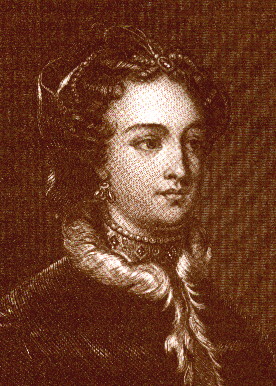 or in any way with food, drink, weapons, shelter, care for the
sick, or transport.
or in any way with food, drink, weapons, shelter, care for the
sick, or transport.
The Campbell Lairds were now Protestants and the MacGregors, as catholic, were
considered not only rebels but papist heretics. The ultra conservative Highlanders
had no conception of the reformation, but indeed, were included in its victims. The
MacGregors were not in the least cowed by the latest proscription, as they soon showed by
their bloodily assertive deeds.
Mary visited Inverary in 1563, and soon after ordered Argyll to stop evicting MacGregors
and replacing them with Campbells. She also ordered him to stop building a fort on
the island of Eilean nam Faoileag at the west end of loch Rannoch. He had
been so afraid of the MacGregors that he had not dare build it on shore.
Nevertheless, after Mary's flight in 1568, he finished the fort and imprisoned MacGregors
in it.
Menzies, another enemy of the MacGregors, had included a part of MacGregor lands in his
title deed but had not dare enter it. Mary ordered him to grant "taks" of
land to landless MacGregors.
This apparent largess on her part was forgotten the next year when she gave Royal Assent
to penalties on those who assisted the MacGregors. The Earl of Argyll was
picturesquely told to raise the shout against clan Gregor and pursue them with "fire and sword." Then there are the documented
cases when some MacGregors were murdered and Mary let some MacGregors out of jail to do
justice with the culprits. Mary must have delighted in running with the MacGregor
'hares' and hunting with the Campbell 'hounds'.
There are scores of accounts in those times where bounty hunters, or criminals, or
betrayers were executed by MacGregor "death squads." In some instances
many years had passed, but vengeance almost always was done when MacGregor heads were
taken. Of course when MacGregor heads were taken, it was considered lawful acts, but
the opposite were denigrated as lawless criminality.
It must be mentioned that the MacGregors were not the only clan to suffer such
atrocities. They were merely the worst case scenario. It was obvious they were
used as an example to cow the other Highlanders into submission. On the contrary,
these shameful government-authorized acts of violence served only to stiffen the
Highlanders' backbone and created the scene for even greater injustices in the future.
![]()
The Slaying of John Drummond
In 1589, John Drummond of Ernich, Royal Forester of Glen Artney, came across
some MacGregors hunting deer on what they considered their own territory. Without the
formality of a trial, Drummond hanged the poaching MacGregors, a common enough punishment
in both England and Scotland for breaking the severe forest and game laws.
No Highlander ever acknowledged game laws, and felt free to take fish, flesh, or fowl in
their own territories. (Even down to modern times, certain Highlanders have not
acknowledged government game laws.) The MacGregors, took Drummond's action as an
affront to be paid back in kind, even though the poachers were a band of outlaws
beyond official clan control.
Some vengeful MacGregors caught Drummond and executed him, similar to the way he had summarily executed the MacGregor hunting party. One account is that they beheaded him. Another account states they cut his hand off. Regardless, they then sat his head (or hand) on a table in his sister's house, to confront her on her arrival home. (Upon sight of the 'head', she fled into the surrounding hills and went quite insane. Later, she was found and was eventually brought back to complete normalcy.)
Some MacGregors later carried his head to the church at Balquhidder. With the heads of the clan present, the young Chief Alasdair of Glenstrae, strode towards the head and put his right hand on it and swore to uphold the deed in defiance of King James. He then urged all present to follow his example, and they did so. In this solemn action the entire clan became enemies of King James VI of Scotland, later King James I of England, a homicidal maniac in his own right.Unfortunately for the MacGregors, Drummond had been hunting for a stag for a dinner at King James VI's wedding feast for Princess Anne of Denmark. Consequently, the king took the affront personally, and another 'crusade' against the MacGregors was launched, called "the General Band."
This one lasting for three merry years, during which, involved many executions or
lynchings of MacGregors. The execution of one MacGregor chief led to the composition
by his wife of one of the most intense love songs in Gaelic literature and music, 'Griogal
Cridhe .' The pipe lament "Cumha Mhic Griogair Ruadh-shruth"
is on this theme.
The Battle of Glen Fruin
(or the rout of a Colquhoun ambush)
James VI, while waiting for his nemesis, Elizabeth I to die, restrained the Scots from
marching into England and avenging the shameful beheading of his mother Mary. He
considered his pending coronation as King of England as comfort enough.
Meanwhile he named Archibald "the Grim" Campbell, 7th Earl of Argyle, who
was already the Justice-General of Scotland, as Warden of the south-west Highlands,
putting him above the law.
On the strength of this new title, Argyle behaved with overwhelming arrogance. He
began paying off old scores with his own relatives. This was not easy as the
MacGregors and Campbells of Argyle got on very well together (as there was a great deal of
intermarriage) and MacGregors were still a powerful force. Argyle now played
a double game, he encouraged the MacGregors to harry the countryside especially his old
enemies, the Colquhouns. When word got out about these raids, he would encourage the
Privy Council to attack the MacGregors with fire and sword
thereby eliminating some of his unruly tenants.
Argyle began quarrelling with the Colquhouns of Luss and he invited the MacGregors to 'commit both hership and slaughter ' upon them. The
clan MacGregor, at this time, welcomed any great man's protection so Alasdair of
Glenstrae, the MacGregor chief, took some of his followers and went down to the rich
Colquhoun lands between Loch Lomond and Loch Long and drove off 420 cows, 400 sheep and
goats and 100 horses. Of course some Colquhouns were killed in the foray.
Since the Earl of Argyle was Justice-General of Scotland, Colquhoun of Luss wisely decided
to ignore his part in the raid and, no doubt encouraged by Argyle, sent the
customary bloody shirt to Edinburgh and asked for Letters of Fire
and Sword against the MacGregors. Due no doubt to Colquhoun's stage
managed show, with paid mourners and hired widows and orphans, he was granted a Royal
Commission to raise a force against the MacGregors.
Word spread fast and furious in the Highlands when interclan battles erupted. Soon
Clan Gregor were aware of the impending raids 'sanctioned by the King'. This was the
kind of situation for which the old Highland Clans were well prepared .
Subsequently, the bloody cross on the 'Cloak of shame' with it fiery cross was making its
hurried rounds throughout Clan Gregor territory, by day and by night, calling all before
it no matter what names they had assumed, to come to the common defence of their lands,
property and families against the 'Saxon' menace..
Alasdair was a rare man, who took the advantage before his opponent had
the wit to seize it, and he prepared to hit the Laird of Luss before he was himself
harried. He gathered four hundred men fully armed. Among them were Camerons,
Campbells, and an eager detachment of MacDonalds. The MacDonalds of Glencoe had
also been used by the Campbell GlenOrchy Lairds in the past. Cutting MacGregor
throats for Campbell paymasters did not prevent Glencoe men from becoming MacGregor allies
in the next generation.
They left the braes (fields) of Balquhidder on a bitter February morning of 1603, crossed
Loch Lomond from Glen Arklet to the Pass of Arrochar, and swung down the eastern shore of
Loch Long to come up on the rear of the Colquhouns. The Laird of Luss had an army of
500 foot and 300 mounted soldiers formed from his own clan, from Buchanan levies, and from
alarmed towns-people of Dumbarton.
In open country, the Colquhoun cavalry could have run down the Highlanders with ease, but
Alasdair placed his foot soldiers across the marshy ground of Glen Fruin at a narrow pass,
where horses were useless. The Lowland infantry broke and ran at once when the
Highlanders charged, their horses were hamstrung and slaughtered in the bogs. It was
over in a few minutes. MacGregors, MacIntoshes, Camerons, Campbells, and MacDonalds
ran over the dead to set fire to every house and stack in the lands of Luss. They
drove off 2000 head of cattle, sheep, goats, and horses. The Battle of GlenFruin was
perhaps the most brilliant battle that Clan Gregor ever fought but it proved to be
its undoing before the court of a psychotic James VI..
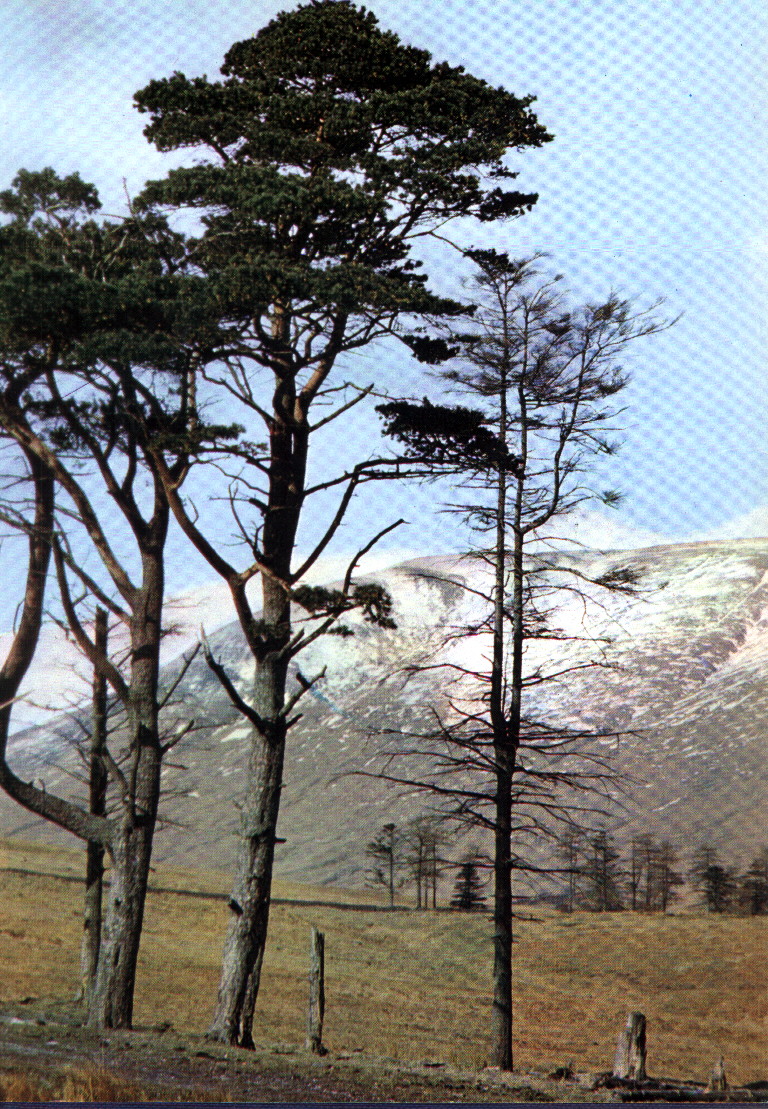
Forty young schoolboy prisoners were held by a MacIntosh man called, 'Allan Og MacIntuach' and he saw no profit in this work when others were enjoying themselves so he cut 40 young Colquhoun throats and rejoined his kinsmen. When Alasdair later asked him where the prisoners were, he replied by holding out his bloody knife and saying "Ask that, and God help me!" (It took the law six years before they could catch up with MacIntuach and hang him.)
Clan MacGregor's rebuttal of a Royal decree could not have come
at a worse time. James was all packed up to go to London and was in no humour to
leave a large area of central Scotland under his antagonists' control. He applied
all the force and fury at his disposal against the MacGregors to destroy them and wipe
them off the face of the earth: his target was Alasdair, who was an honest man and
accepted responsibility.
In a deed of treachery, Argyle, Alasdair's mentor, captured him, but could not hold
him. Alasdair slipped away from a boat and swam off in the dark. Later on, he
got a solemn promise from Argyle that if he surrendered, he would be taken out of the
country to England. Alasdair decided to take the chance with the English.
Argyle kept his word, fulfilling it to the letter, but broke it in the spirit. Alasdair and eleven sub-chiefs were taken to the English border, then immediately escorted to Edinburgh to face trial. He was hanged along with his eleven followers after a quick trial. For his work in suppressing disorder in the Highlands (which was to include the near extermination of the MacGregors) the Crown gave Argyle all the lands in Kintyre.
For many years afterwards, MacGregors and their allies were hunted down and summarily executed merely on allegations that they were at the Battle of Glen Fruin.Another Account of the MacGregor/Colquhoun
CLAN COLQUHOUN
Clan Colquhoun genealogists claim that their line began when Conoch came to Scotland from Ireland during the rule of Gregory the Great, during 875-891, and that they obtained their lands from that monarch. It is said that the name Conoch evolved to Conochon, and later Colquhoun. The Colquhoun family name, however, comes from the lands bearing the same name west of Loch Lomond. During the reign of Alexander II, King of Scotland from 1214 - 1249, Humphrey Kilpatrick, whom some genealogists claim was the younger brother of the Kirkpatrick Lord of Closeburn, was granted these lands by Malcom, the Earl of Lennox.
THE TROUBLE BEGINS
Amelia Georgiana Murray MacGregor, writing in 1898 in the "History of the Clan Gregor," states that MacGregor of Ardinconnell, one of the oldest offshoots of the clan, was the branch most involved in the disputes with Colquhoun of Luss. The earliest record of any dispute is a Deed of Resignation dated February 7th, 1429, transferring Gleane Mackerne (Glen Mackurn) to John Colquhoun of Luss. Documents signed throughout the 1400s and 1500s indicate that the Colquhouns, like the Campbells, wanted MacGregors' lands and were successful in their efforts.
Clan Gregor, however, managed to remain one of the most powerful highland clans until 1519, when the expansion of the Campbells created a problem of a different type. When a young MacGregor boy "ravaged" a Campbell heiress the girl's family used the incident to their advantage. The boy was forced to marry the Campbell heiress and became the chief of the MacGregors. However, his actions were under the full control of the Campbells, who used the puppet-chief to take over more MacGregor lands. Meanwhile, the true chiefly heirs continued their struggles as guerrilla fighters in the mountains of Argyle and Perthshire, where they became known as the "Children of the Mist." With their lands now in the hands of the Campbells, the MacGregors had no other option than stealing cattle or poaching.
According to the "History of The Clan Gregor," serious trouble began in 1527, when Patrick MacGregor of Laggarie, "despoiled the father of the then Laird of Luss of a considerable number of oxen and cows." To obtain redress for the theft of his father's property, John Colquhoun summoned MacGregor on December 27, 1540 to appear before the Lords of the Privy Council who commanded MacGregor to restore to Colquhouns "eight oxen, twelve milk cows, or the price of them with profits of them since the year 1527."
MacGregor, however, did not comply, and on May 30, 1541, was prohibited from selling any "heritable properties" until the bill was paid. Unable to sell anything of value, this prohibition would have caused an impasse. How could MacGregor pay his bill if he could not engage in commerce?!
GLEN LUSS
In 1602 the MacGregors attacked the Colquhouns in Glen Luss, killing two clansmen, injuring others, and stealing livestock.
Rather than respond with violence, the Colquhouns traveled to King James VI seeking redress. Instead of merely presenting a petition, the Colquhouns staged a visual production. About fifty women, each displaying men's torn and bloodied clothing on poles, rode white ponies through the narrow streets that led to the castle. While the effect was compelling, most historians agree that pigs' blood and old garments were used to amplify the effect. The stunt, however, served its purpose and the king responded by granting the Colquhouns permission to pursue the MacGregors with "fire and sword."
GLEN FRUIN
The MacGregors were not show to react. According to one account, Alexander of Glenstrae, the MacGregor chief, went to Luss in 1602 to negotiate on behalf of his clan. The meeting went smoothly and Glenstrae and his men returned home towards Rannach. The Colquhoun chief, however, did not trust the MacGregors and quickly gathered a group of his own followers, which included the Buchanans and the Graemes, and totaled about 500 horsemen and another 300 on foot. The group pursued the MacGregors, who traveled hom by way of Glen Fruin. There being no road, the MacGregors were traveling through the floor of the valley when the Colquhoun forces attacked without provocation.
The MacGregors, however, were reputed to possess "the sight," and are said to have been able to foretell the future. Whether "the sight" played a role in the events that afternoon is anyone's guess. However, Alastair MacGregor most certainly had a premonition of impending trouble and, prior to the attack, divided his men into two groups. The party traveling through the valley floor was not alone. Concealed along the ridge above, the second group watched the mayhem below.
While Alasdair maintained combat with his own group on the valley floor, his brother's men made the circuit of the hill and attacked the unsuspecting assailants from the rear. It is said that no fewer than 200 Colquhouns were slain. But although many of the MacGregors were wounded, the only persons killed were the brother of the chief and one other.
The MacGregors, however, were far from being "the winners." When the king learned of the massacre he ordered the entire MacGregor clan outlawed and condemned to extermination.
To hear The Rout of
Glen Fruin click here
![]()
James VI Decrees the MacGregors into Extinction
The MacGregors were by law, stripped of everything that humans regard as the necessities
of life; food, drink, shelter, care of babies, aged and sick, or that Christian of
whatever persuasion had always regarded as their right, whether within or without the law,
the Sacraments of baptism, marriage, and burial.
A special Act of Council was passed outlawing the whole MacGregor clan and forbidding
anyone on pain of death even to bear the surname of MacGregor . All these were
denied Clan Gregor, and in addition, there were instituted deprivations and insults so
brutal that beasts would not have been subjected to them. Women associated with
MacGregor men were branded with hot branding irons and whipped naked through towns at the
tail of a cart. Children were torn from their mothers and farmed out in batches at the
mercy of the keepers.
In a barbaric extreme of retribution, Royal Warrants were decreed for MacGregor scalps to
be used as legal tender, in an effort to undermine MacGregor sympathizers. Copies
still exist today of the original warrants and records of rent being paid in MacGregor
scalps. Notorious criminals were offered amnesty if they would bring in a certain
number of MacGregor scalps. Even certain MacGregor criminals, were offered release
upon delivery of six MacGregor scalps.
But still the MacGregors were not obliterated. Retreating to their mountain fastness, they hid out amongst the countryside they knew only too well. Hunted and beleaguered by day, they were masters of the night. They were forced to wait another 58 years in their mountain fastness before the name MacGregor would be temporarily declared legal again by none other than the "Lord Protector of England", Cromwell himself, not because he sympathized with the MacGregors, but because he had a very strong sense of fair play.
The hunted MacGregors were not merely one group, but many, each with its Chief and a land base. The MacGregors were so prolific that they actually increased in numbers. They had some friends, such as the Laird of Clan Grant, who in one court incident, incurred fines of 27,000 pounds for his efforts on behalf of the MacGregors. (He was later fully reimbursed by Rob Roy). The Grants claimed kinship with the MacGregors, and were descended from a Gregor Mhor MacGregor, who lived in the 12th century. The bond of family, no matter how far back, held hard in the Highlands.![]()

The outlawed Clan Gregor were frequently pursued with bloodhounds,
known in Gaelic as conn dubh or 'black dogs'. This gun is inscribed 'This
is the fuzee with which the last of the Blood-Hounds used for tracking the MacGregors is
said to have been killed".
The hound in question was shot by Malcom Og MacGregor, chieftain of the
Clan Dubh-ghaill Ciar in Glengyle, who in 1624, led 300 clansmen to help the Earl of Moray
against a raiding party of the Clan Chattan in Petty. He shot it near Lochearnhead,
on the slope of a hill still called 'Meall a Mhadaidh ', the Hill of
the Wild Dog. Of him it was also said that it was 'Callum Oig' (Gaelic translation)
who, whilst shut up with the Clan on the island on Loch Katrine in 1611, shot one of the
besiegers dead with a long barreled gun.
The Grants are descended from Gregor Mhor MacGregor, second son of Malcolm, Morear nan Castal. They carry the same Suaitheanntas or mark of distinction, i.e. a branch of fir, and as the MacGregors carried an imperial crown proper, in the shield, the Grants assumed three crowns, as a mark of cadency. So true it is they esteem themselves one people, that for fourteen days at the end of 1725 and beginning of 1726, there was a celebrated meeting between those Clans at Blair-Atholl, in order to bring it about that they should assume one surname.
At this meeting it was unanimously resolved that application should be
made for restoring the name of MacGregor and if that failed the MacGregors agreed that
either MacAlpine or Grant should be the common name, but insisted at all events that
MacGregor should be Chief of the united Clan; while it was represented for Grant that as
he had now greater interest at Court, it was more proper to choose him Chief, but the
Mother Clan would not hearken to these terms; and such a proposal being made, together
with the Laird of Grant's having only attended by proxies, displeased the MacGregors and
prevented a general agreement, tho' some gentlemen of both Clans at that time assumed
the ancient name of MacAlpin.
The MacGregors present, whose surname was now proscribed, were willing to take that of
Grant, providing that John McGregor of Glencarnock lineal male representative of MacGregor
of Breachdsliabh, as the heir male of the Laird of MacGregor, was made Chief of the united
Clan, but upon no other condition whatever." "And, I remember " (continues
a person who was present at the meeting, and addressed a letter upon the subject to John
Murray Esqr afterward Sir John MacGregor Murray Baronet, dated at, Edinburgh 30th August
1769) "that a protestation or dissent was offered in the said John your grandfather's
name, declaring that nothing done at the said meeting should prejudge his undoubted right
of Chiefship of the MacGregors, which he declared he would not give up to the Laird of
Grant, or any other person, who were all come of his ancient Family, and that these
protests, with the Laird of Grant's not being personally present, hindered the agreement.
There are," he adds, "many people as well as me, who must remember this."
The MacGregors Lament In Song
The suffering and torment of an entire race - (the last of
the Picts) being set upon as condemned animals by the very government which should have
been devoted to improving the lifestyle of all its citizens, resulted in the most
melancholy of Scottish tunes. Many MacGregor tunes have been over the years,
misrepresented, convoluted, and ridiculed, but some are so profound as to become
integral parts of Scottish heritage.
Some MacGregor tunes are very well known, particularly the "MacGregors Gathering"
a Gaelic air altered and set to rather fustian words by Sir Walter Scott. "The
Rout of Glen Fruin", "The Burning of the Black Mill"
and "The Braes of GlenOrchy " are still used as standard
bagpipe tunes. Lesser known is the funeral song "Cha till mi tuilich",
(I shall return no more.)
Above all, the universally loved tune 'Loch Lomond' represents the soul of
Scotland set to music. Its haunting rendition of a premonition of death and an
after-life reunion with a loved one, brings tears of emotion to all who hear it.
Most people who have heard it believe it was a story of a soldier going off to war and
believing he would not come back alive. What most people do not realize is that it
was actually composed by a condemned MacGregor, under sentence of death in Carlisle
Castle, in 1746.
It represents an ancient Pictish belief that the ghost of slain
soldiers who died far from home travelled under the earth to haunt the place dearest in
memory. The condemned man was a native of Glen Endrick, on the south-east of
Loch Lomond, and was taken into custody just across the border, in England, along with a
friend, because of their earlier support for Bonnie Prince Charlie. The friend was
releaed but the MacGregor was sentenced to hang (as was the usual custom whenever the
authorities got hold of a genuine MacGregor). Therefore, he told his friend to take
the high road back to Scotland and he would take the low (below ground) road. The
original words of course were Gaelic, but the English translation is still highly
profound.. To listen to a rendition of
"Loch Lomond"click here.
"How The Mighty Have Fallen!" The marching song of the
MacGregors, which struck terror into all who heard it was a lively chant which has been so
far reduced in effect that it is now a street song for many Scottish children. It
goes by the name, "In and out of the dusty bluebells".
At one point, Rob Roy was captured and kept in Newgate
prison. He was about to be deported to Barbados and a certain death by malaria, when
his Royal pardon came through. His wife, Mary, composed 'Rob Roy's Lament'
as a tribute to his suffering during his imprisonment.
![]()
In the face of misfortune, the Gregor clan remained proud and defiant. Sir Walter
Scott wrote a poem entitled 'MacGregor's Gathering' to describe the clan's
situation in those dark days, which goes something like this:
The moon's on the lake, and the mist's on the brae
And the Clan has a name that is nameless by day;
Then gather, gather, gather, Gregarach!
Our signal for fight, that from monarchs we drew,
Must be heard but by night in our vengeful haloo!
Then haloo, Gregarach! haloo, Gregarach!
Glen Orchy's proud mountains, Kilchurn and her towers,
Glenstrae and Glenlyon no longer are ours;
We're landless, landless, landless, Gregarach!
But doomed and devoted by vassal and lord.
MacGregor has still both his heart and his sword!
Then courage, courage, courage, Gregarach!
If they rob us of name, and pursue us with beagles,
Give their roofs to the flame, and their flesh to the Eagles!
Then vengeance, vengeance, vengeance, Gregarach!
While there's leaves in the forest, and foam on the river,
MacGregor, despite them, shall flourish forever!
Come then, Gregarach, come then, Gregarach,
Through the depths of Loch Katrine the steed shall career,
O'er the peak of Ben-Lomond the galley shall steer!
And the rocks of Craig-Royston like icicles melt,
Ere our wrongs be forgot, or our vengeance unfelt!
Then gather, gather, gather, Gregarach!
To listen to the song click here
Editor's Note: Though the above verse is based on fact, many of its roots have been challenged by a revisionist history in today's Scotland, with a view to erase many MacGregor accomplishments rather than admit to hundreds of years of a state sponsored genocide. As Forbes MacGregor wrote in his forward to "Clan Gregor", one who writes about our clan must 'not be in awe of Caesar' (nor of his minions).
![]()